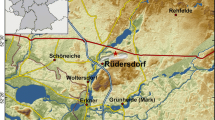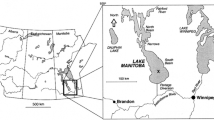Abstract
Sediment cores from Lakes Punta Laguna, Chichancanab, and Petén Itzá on the Yucatan Peninsula were used to (1) investigate “within-horizon” stable isotope variability (δ18O and δ13C) measured on multiple, single ostracod valves and gastropod shells, (2) determine the optimum number of individuals required to infer low-frequency climate changes, and (3) evaluate the potential for using intra-sample δ18O variability in ostracod and gastropod shells as a proxy measure for high-frequency climate variability. Calculated optimum sample numbers (“n”) for δ18O and δ13C in the ostracod Cytheridella ilosvayi and the gastropod Pyrgophorus coronatus vary appreciably throughout the cores in all three lakes. Variability and optimum “n” values were, in most cases, larger for C. ilosvayi than for P. coronatus for δ18O measurements, whereas there was no significant difference for δ13C measurements. This finding may be explained by differences in the ecology and life history of the two taxa as well as contrasting modes of calcification. Individual δ18O measurements on C. ilosvayi in sediments from Lake Punta Laguna show that samples from core depths that have high mean δ18O values, indicative of low effective moisture, display lower variability, whereas samples with low mean δ18O values, reflecting times of higher effective moisture, display higher variability. Relatively dry periods were thus consistently dry, whereas relatively wet periods had both wet and dry years. This interpretation of data from the cores applies to two important periods of the late Holocene, the Maya Terminal Classic period and the Little Ice Age. δ18O variability during the ancient Maya Terminal Classic Period (ca. 910–990 AD) indicates not only the driest mean conditions in the last 3,000 years, but consistently dry climate. Variability of δ13C measurements in single stratigraphic layers displayed no relationship with climate conditions inferred from δ18O measurements.







Similar content being viewed by others
References
Brenner M, Rosenmeier MF, Hodell DA, Curtis JH (2002) Paleolimnology of the Maya Lowlands. Long-term perspectives on interactions among climate, environment, and humans. Ancient Mesoam 13:141–157
Chivas AR, De Deckker P, Shelley JMG (1985) Strontium content of ostracods indicates lacustrine palaeosalinity. Nature 316:251–253
Covich AP, Stuiver M (1974) Changes in oxygen 18 as a measure of long-term fluctuations in tropical lake levels and molluscan populations. Limnol Oceanogr 19:682–691
Craine ER, Reindorp C (1979) The Codex Perez and the book of Chilam Balam of Mani. University of Oklahoma Press, Norman
Curtis JH, Hodell DA, Brenner M (1996) Climate variability on the Yucatan Peninsula (Mexico) during the past 3,500 years, and implications for Maya cultural evolution. Quat Res 46:37–47
Curtis JH, Brenner M, Hodell DA, Balser RA, Islebe GA, Hooghiemstra H (1998) A multi-proxy study of Holocene environmental change in the Maya Lowlands of Peten, Guatemala. J Paleolimnol 19:139–159
De Deckker P, Chivas AR, Shelley JMG, Torgersen T (1988) Ostracod shell chemistry—a new palaeoenvironmental indicator applied to a regressive–transgressive record from the Gulf of Carpentaria, Australia. Palaeogeogr Palaeoclimatol Palaeoecol 66:231–241
Dettman DL, Reische AK, Lohmann KC (1999) Controls on the stable isotope composition of seasonal growth bands in freshwater bivalves (unionidae). Geochim Cosmochim Acta 63:1049–1057
Ferguson E (1944) Studies on the seasonal life history of three species of freshwater Ostracoda. Am Midl Nat 32:713–727
Fontes JC, Gonfiantini R (1967) Comportement isotopique au cours de l’evaporation de deux bassins sahariens. Earth Planet Sci Lett 3:258–266
Giddings L, Soto M (2003) Rhythms of precipitation in the Yucatan Peninsula. In: Gomez-Pompa A, Allen MF, Fedick SL, Jimenez-Osornio JJ (eds) The Lowland Maya: three millennia at the human–wildland interface. Haworth Press, Binghamton, pp 77–89
Gill RB (2000) The great Maya droughts: water, life, and death. University of New Mexico Press, Albuquerque
Heaton THE, Holmes JA, Bridgwater ND (1995) Carbon and oxygen isotope variations among lacustrine ostracods: implications for palaeoclimatic studies. Holocene 5:428–434
Hodell DA, Curtis JH, Brenner M (1995) Possible role of climate in the collapse of classic Maya civilization. Nature 375:391–394
Hodell DA, Brenner M, Curtis JH, Medina-Gonzalez R, Ildefonso-Chan Can E, Albornaz-Pat A, Guilderson TP (2005) Climate change on the Yucatan Peninsula during the little ice age. Quat Res 63:109–121
Hodell DA, Brenner M, Curtis JH (2007) Climate and cultural history of the Northeastern Yucatan Peninsula, Quintana Roo, Mexico. Clim Change 83:215–240
Holmes JA (2008) Sample-size implications of the trace-element variability of ostracod shells. Geochim Cosmochim Acta 72:2934–2945
Holmes JA, Street-Perrott FA, Allen MJ, Fothergill PA, Harkness DD, Kroon D, Perrott RA (1997) Holocene palaeolimnology of Kajemarum Oasis, Northern Nigeria: an isotopic study of ostracodes, bulk carbonate and organic carbon. J Geol Soc 154:311–319
Jones MD, Leng MJ, Eastwood WJ, Keen DH, Turney CSM (2002) Interpreting stable-isotope records from freshwater snail-shell carbonate: a holocene case study from Lake Göhisar, Turkey. Holocene 12:629–634
Koutavas A, de Menocal PB, Olive GC, Lynch-Stieglitz J (2006) Mid-Holocene El Nino–Southern Oscillation (ENSO) attenuation revealed by individual foraminifera in eastern tropical Pacific sediments. Geology 34:993–996
Leng MJ, Marshall JD (2004) Palaeoclimate interpretation of stable isotope date from lake sediment archives. Quat Sci Rev 23:811–831
Leng MJ, Roberts N, Reed JM, Sloane HJ (1999) Late quaternary climatic and limnological variations based on carbon and oxygen isotope data from authigenic and ostracods carbonate in the Konya basin, Turkey. J Paleolimnol 22:187–204
Leyden BW, Brenner M, Hodell DA, Curtis JH (1993) Late pleistocene climate in the central American lowlands. In: Swart PK, Lohmann KC, McKenzie J, Savin S (eds) Climate change in continental isotopic records. Geophysical Monograph 78. American Geophysical Union, Washington, DC, pp 165–178
McConnaughey TA, Burdett J, Whelan JF, Paull CK (1997) Carbon isotopes in biological carbonates: respiration and photosynthesis. Geochim Cosmochim Acta 61:611–622
McGregor DL (1969) The reproductive potential, life history and parasitism of the freshwater ostracod Darwinula stevensoni; (Brady and Robertson). In: Neale JW (ed) The taxonomy, morphology and ecology of recent Ostracoda. Oliver and Boyd, Edinburgh, pp 194–221
McKenzie JA, Hollander DJ (1993) Oxygen-isotope record in recent carbonate sediments from Lake Greifen, Switzerland (1750–1986): application of continental isotopic indicator for evaluation of changes in climate and atmospheric circulation patterns. In: Swart PK, Lohmann KC, McKenzie J, Savin S (eds) Climate change in continental isotopic records, Geophysical Monograph 78, American Geophysical Union, pp 101–111
McLay CL (1978) Comparative observations on the ecology of four species of ostracods living in a temporary freshwater puddle. Can J Zoolog 56:663–675
Meisch C (2000) Freshwater ostracoda of western and central Europe. Süßwasserfauna von Mitteleuropa 8/3. Gustav Fischer, Stuttgart, p 522
Mueller AD, Islebe GA, Hillesheim MB, Grzeisk DA, Anselmetti FS, Ariztegui D, Brenner M, Curtis JH, Hodell DA, Venz KA (2009) Climate drying and associated forest decline in the lowlands of northern Guatemala during the late holocene. Quat Res 71:133–141
Okada Y (1982) Structure and cuticle formation of the reticulated carapace of the ostracode Bycornucythere bisanensis. Lethaia 15:85–101
Palacios-Fest MR, Dettman DL (2001) Temperature controls monthly variation in Ostracode valve Mg/Ca: Cypridopsis vidua from a small lake in Sonora, Mexico. Geochim Cosmochim Acta 65:2499–2507
Peypouquet JP, Carbonel P, Ducasse O, Tolderer-Farmer M, Lete C (1988) Environmentally cued polymorphism of ostracods. In: Hanai T, Ikeya T, Ishizaki K (eds) Evolutionary biology of Ostracoda. Its fundamentals and applications. Elsevier, Amsterdam
Ricketts RD, Johnson TC (1996) Early holocene changes in lake level and productivity in Lake Malawi as interpreted from oxygen and carbon isotopic measurements from authigenic carbonates. In: Johnson TC, Odada EO (eds) The limnology, climatology and palaeoclimatology of the east Africa lakes. Gordon and Breach, Amsterdam
Shanahan TM, Pigati JS, Dettman D, Quade J (2005) Isotopic variability in the aragonite shells of freshwater gastropods living in springs with nearly constant temperature and isotopic composition. Geochim Cosmochim Acta 69:3949–3966
Simstich J, Stanovoyb V, Baucha D, Erlenkeuser H, Spielhagena RF (2004) Holocene variability of bottom water hydrography on the Kara Sea shelf (Siberia) depicted in multiple single-valve analyses of stable isotopes in ostracods. Mar Geol 206:147–164
Talbot MR, Kelts K (1986) Primary and diagenetic carbonates in the anoxic sediments of Lake Bosumtwi, Ghana. Geology 14:912–916
Turpen JB, Angell RW (1971) Aspects of molting and calcification in the ostracod Heterocypris. Biol Bull 140:331–338
von Grafenstein U, Erlernkeuser H, Trimborn P (1999) Oxygen and carbon isotopes in modern fresh-water ostracod valves: assessing vital offsets and autecological effects of interest for palaeoclimate studies. Palaeogeogr Palaeoclimatol Palaeoecol 148:133–152
Wilson EM (1984) Physical geography of the Yucatan Peninsula. In: Moseley EH, Terry ED (eds) Yucatan: a world apart, 2nd edn. University of Alabama Press, Tuscaloosa, pp 5–40
Xia J, Engstrom DR, Ito E (1997) Geochemistry of ostracode calcite: part 2. The effect of water chemistry and seasonal temperature variation on Candona rawsoni. Geochim Cosmochim Acta 61:383–391
Acknowledgments
Coring on Lakes Punta Laguna and Chichancanab was funded by NOAA Grant NA36GP0304. Coring at Lake Petén Itzá was supported by NSF grant EAR-9709314 and a grant from the National Geographic Society. Stable isotope analyses were funded by the University of Florida (UF) Stable Isotope Mass Spectometry Laboratory, the UF School of Natural Resources and Environment, and the UF Land Use and Environmental Change Institute (LUECI). Final revisions to the manuscript were done at the Center for Tropical Paleoecology and Archaeology (CTPA) at the Smithsonian Tropical Research Institute (STRI). We thank two anonymous reviewers and Associate Editor Piero Guilizzoni for helpful comments on the manuscript.
Author information
Authors and Affiliations
Corresponding author
Rights and permissions
About this article
Cite this article
Escobar, J., Curtis, J.H., Brenner, M. et al. Isotope measurements of single ostracod valves and gastropod shells for climate reconstruction: evaluation of within-sample variability and determination of optimum sample size. J Paleolimnol 43, 921–938 (2010). https://doi.org/10.1007/s10933-009-9377-9
Received:
Accepted:
Published:
Issue Date:
DOI: https://doi.org/10.1007/s10933-009-9377-9




